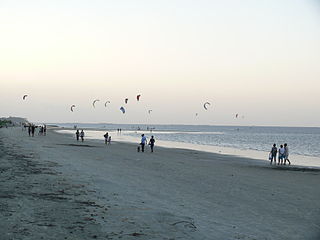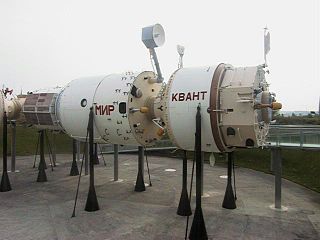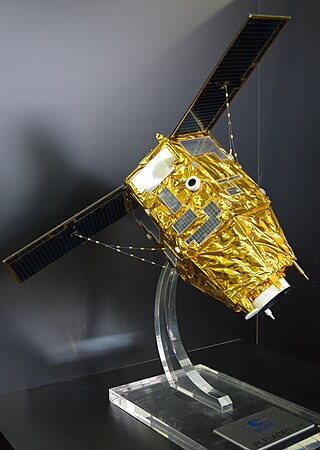
Kourou is a commune in French Guiana, an overseas region and department of France in South America. Kourou is famous for being the location of the Guiana Space Centre, the main spaceport of France and the European Space Agency (ESA). It is an administrative district in French Guiana and the main town there.

The Diamant rocket was the first exclusively French expendable launch system and at the same time the first satellite launcher not built by either the United States or USSR. As such, it has been referred to as being a key predecessor for all subsequent European launcher projects.
Ariane 2 was a European expendable space launch vehicle, operated by the European Space Agency (ESA) between 1986 and 1989 as part of Ariane family of rockets. The principal manufacturer for the Ariane 2 was Aérospatiale, while the lead agency for its development was the Centre National d'Etudes Spatiales (CNES), the French government's space agency.

The Guiana Space Centre, also called Europe's Spaceport, is a European spaceport to the northwest of Kourou in French Guiana, a region of France in South America. Kourou is located approximately 310 mi (500 km) north of the equator at a latitude of 5°. In operation since 1968, it is a suitable location for a spaceport because of its equatorial location and open sea to the east.

Hermes was a proposed spaceplane designed by the French Centre National d'Études Spatiales (CNES) in 1975, and later by the European Space Agency (ESA). It was superficially similar to the American Boeing X-20 Dyna-Soar and the larger Space Shuttle.

The National Centre for Space Studies is the French national space agency headquartered in central Paris and it comes under the supervision of the French Ministries of Defence and Research.

A mission control center is a facility that manages space flights, usually from the point of launch until landing or the end of the mission. It is part of the ground segment of spacecraft operations. A staff of flight controllers and other support personnel monitor all aspects of the mission using telemetry, and send commands to the vehicle using ground stations. Personnel supporting the mission from an MCC can include representatives of the attitude control system, power, propulsion, thermal, attitude dynamics, orbital operations and other subsystem disciplines. The training for these missions usually falls under the responsibility of the flight controllers, typically including extensive rehearsals in the MCC.
Météo-France is the French national meteorological service.

The Cité de l'espace is a scientific discovery centre in France focused on spaceflight. It was opened in June 1997, and is located on the eastern outskirts of Toulouse. It was carried out on the initiative of the Town Hall of Toulouse with the participation of numerous partners such as the Regional Council of Midi-Pyrénées, the Ministries of Equipment, Transport, Defence, National Education, Research and Technology, the National Center for Space Studies (CNES), Météo-France, EADS, Astrium, among others. As of 2012, there had been more than four million visitors.

The Pléiades constellation is composed of two very-high-resolution optical Earth-imaging satellites. Pléiades-1A and Pléiades-1B provide the coverage of Earth's surface with a repeat cycle of 26 days. Designed as a dual civil/military system, Pléiades will meet the space imagery requirements of European defence as well as civil and commercial needs.
The French space program includes both civil and military spaceflight activities. It is the third oldest national space program in the world, after the Soviet and American space programs, and the largest space program in Europe.
The Institut au service du spatial, de ses applications et technologies (ISSAT), is a French association supported by French Ministry of Education, created in 1995 in order to develop the aerospace activities in Toulouse and to help developing the knowledge of aerospace in France and Europe

The European contribution to the International Space Station comes from 10 members of the European Space Agency (ESA) and amounts to an 8% share in the programme. It consists of a number of modules in the US Orbital Segment, ATV supply ships, launchers, software and €8 billion.

Vegetation and Environment monitoring on a New Micro-Satellite (VENµS) is a near polar sun-synchronous orbit microsatellite. It is a joint project of the Israeli Space Agency and CNES. The project was signed upon in April 2005 and was launched on the 2nd of August 2017. The microsatellite, which was set to cost the ISA US$20 million and CNES €10 million, was designed and built by IAI and Rafael under ISA's supervision.
Athena-Fidus is a French-Italian telecommunication satellite providing high-throughput secure communications to both nation's armed forces and their emergency services. It was manufactured by Thales Alenia Space under the supervision of CNES, the Direction générale de l'armement (DGA) and the Italian Space Agency (ASI). It complements the lower-throughput but more secure Syracuse 3 satellites. The satellite has a wet mass of 3080 kg and was placed on geostationary orbit in 2014. Its expected lifetime is 15 years.

Jacques Émile Blamont was a French astrophysicist, author and the founder scientific and technical director of National Centre for Space Studies, known to have contributed to the development of Veronique, the first rocket launched by France in 1957. He was an elected fellow of the French Academy of Technologies and a professor emeritus of the Pierre and Marie Curie University.

ArianeGroup is an aerospace company based in France. A joint venture between Airbus and Safran, the company was founded in 2015 and is headquartered in Issy-les-Moulineaux. It consists of three core arms: aerospace, defence and security. ArianeGroup is currently developing its next-generation two-stage Ariane 6 launch vehicle, intended to succeed the Ariane 5 rocket, which has been launched more than 110 times. The new vehicle will be offered in two variants that will be capable of carrying between 10,350 and 21,650 kilograms. The first launch of Ariane 6 is expected to occur in 2023.

Rangueil is a residential area south-east of Toulouse in Haute-Garonne, France, where grandes écoles and Universities are located as well as an important scientific complex. It has 2,295 inhabitants (2018).

Vega flight VV16, also called SSMS PoC Flight, was the 16th launch of the Vega rocket. The launch was also notable as it was the first Vega launch following the accident of the VV15 launch in July 2019 that caused the loss of FalconEye1 satellite.
Starlette and Stella are nearly identical French geodetic and geophysical satellites. Starlette was launched on 6 February 1975 and Stella on 26 September 1993. Starlette was the first passive laser satellite developed.













